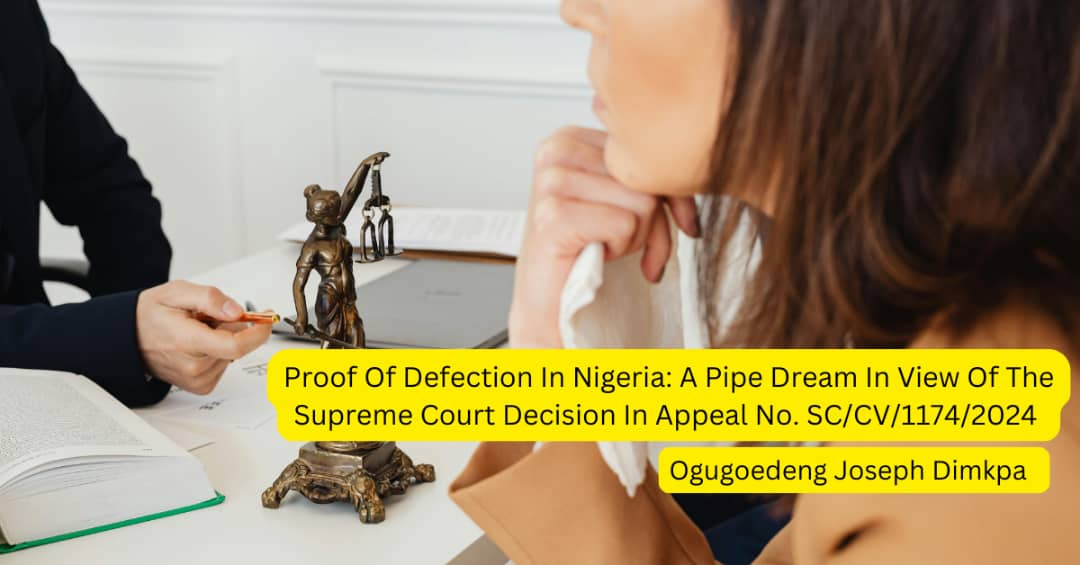Category: Supreme Court
-

Proof Of Defection In Nigeria: A Pipe Dream In View Of The Supreme Court Decision In Appeal No. SC/CV/1174/2024 This article considers proof of membership of another political party after defection, as condition precedent for a member of parliament to lose his seat. This is in view of the Supreme Court judgement in Appeal No.…
-
Uzoho & Ors V. National Council Of Privatization & Anor (2022) LAWGLOBAL HUB Lead Judgment Report CHIMA CENTUS NWEZE, J.S.C. The appellants, herein, commenced an action by way of Originating Summons at the Federal High Court, Abuja Judicial Division (hereinafter, simply, referred to as “the Trial Court”). They sought both declaratory and injunctive reliefs against…
-
Usman V. State (2022) LAWGLOBAL HUB Lead Judgment Report IBRAHIM MUHAMMED MUSA SAULAWA, J.S.C. The present appeal is against the judgment of the Court of Appeal, Akure Judicial Division delivered on December 6, 2018 in appeal no. CA/AW282C/2016. By the judgment in question, the Court below coram Danjuma, Abdullahi and Mahmoud, JJCA, dismissed the Appellant’s…
-
Universal Properties Ltd V. Pinnacle Commercial Bank & Ors (2022) LAWGLOBAL HUB Lead Judgment Report JOHN INYANG OKORO, J.S.C. This is an appeal against the judgment of the Court of Appeal Lagos Division delivered on 14th of April, 2008 wherein the lower Court dismissed in limine the appeal filed by the Appellant which was pending…
-
Umeano & Ors V. Anaekwe & Anor (2022) LAWGLOBAL HUB Lead Judgment Report KUDIRAT MOTONMORI OLATOKUNBO KEKERE-EKUN, J.S.C. The appellants were plaintiffs at the trial Customary Court (CC) Akwuzu, Anambra State in Suit No. CCA/2/92: Alexander Umeano & Ors Vs Albert Anaekwe & Anor wherein they sought the following reliefs: (a) Defendant to remove the…
-
Uba V. Ozigbo & Ors (2021) LAWGLOBAL HUB Lead Judgment Report JOHN INYANG OKORO, J.S.C. This is an appeal against the judgment of the Court of Appeal Awka Judicial Division, holden at Enugu and delivered on 3rd September, 2021 wherein the Court below set aside the judgment of O. A. Nwabunike, J of the High…
-
Uba Plc V. Mabogunje (2022) LAWGLOBAL HUB Lead Judgment Report ADAMU JAURO, J.S.C. This appeal is against the judgment of the Court of Appeal, Lagos Judicial Division, which dismissed the Appellant’s appeal against the judgment of the High Court of Lagos State delivered on 4th March, 2014. The Court below affirmed the declaratory reliefs amongst…
-
U.t.c. (Nig) Plc V. Peters (2022) LAWGLOBAL HUB Lead Judgment Report OLUKAYODE ARIWOOLA, J.S.C. This is an appeal against the judgment of the Port Harcourt division of the Court of Appeal, delivered on Thursday 19th February, 2009 – Coram: Kudirat M. O. Kekere-Ekun, Ibrahim M. M. Saulawa, Ejembi Eko, JJCA (as they then were) all…
-
The Incorporated Trustees Of Ladies Of Saint Mulumba, Nigeria V. Ekhator (2022) LAWGLOBAL HUB Lead Judgment Report AMINA ADAMU AUGIE, J.S.C. The Applicant as Claimant, filed a suit against the Respondent at the Edo State High Court, involving “a piece or parcel of land situate and known as Ward 40/B Aduwawa Area, Benin City”. At…
-
Taiwo V. Frn (2022) LAWGLOBAL HUB Lead Judgment Report MARY UKAEGO PETER-ODILI, J.S.C. This is an appeal against the judgment of the Court of Appeal, Lagos Division or lower Court or Court below, Coram: Nimpar, Ogakwu and Obaseki-Adejumo JJCA delivered on the 13th April, 2018 in which the appellant’s conviction and sentence by the trial…
